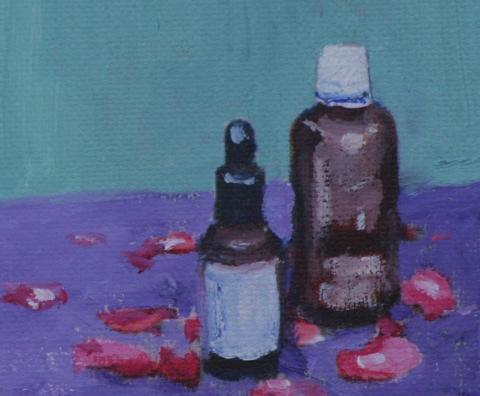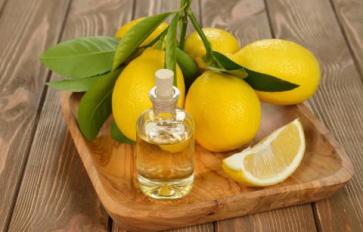
When I first studied aromatherapy and learned that perfumery was part of the course I thought “Well, that part’s going to be boring.” Perfumery is now my favorite part of aromatherapy. Natural perfumes are fun to make and the more developed your nose gets from blending, the more nuanced your perfumes will be.
Step-by-step perfume making
1. Choose the purpose of the blend. For example, is it a seasonal scent for a friend, or a relaxing blend for a stressed client? This is especially helpful when you’re an oil junkie like me and have dozens of them from which to choose.
2. Decide on desired scent characteristic(s). Some scent descriptors include sweet, floral, musky, musty, smokey, earthy, spicy, sharp, balsamic, citrusy, fruity, fresh or green. Can you come up with other scent descriptors? If so, make yourself a list for future reference. Multiple of these qualities can make up a blend. For instance, a sweet and floral blend, an earthy and balsamic scent or a spicy citrus perfume. Today’s sample blend is fresh, green, and a bit spicy—a forest blend, as it were!
3. Balance your blend: Top, middle and base notes. A musical scale is a common framework used in perfumery to make sure a perfume is well-rounded. Some oils are heavy. They have large scent molecules that evaporate slowly and help slow evaporation of the lighter oils in a perfume. These are the “base notes” of a blend that last and give the perfume some body. Some of my favorite base notes are frankincense, vetiver, jasmine, and cedar moss.
At the other end of the scale are the top notes. Some examples of top notes are citrus oils like grapefruit, bergamot, and tangerine. These contain the smallest scent molecules, which evaporate quickly and are thus the first scents you notice when you smell a perfume. Middle notes tie the top and base notes together and round out the blend. Middle notes I frequently use include cypress, cardamom, black pepper, marjoram, and geranium.
Some oils like lavender and fir are both top and middle notes. Others, like cedarwood and ylang ylang are middle and base notes. Then there are oils like rose and neroli that are all three! Veritable perfumes in and of themselves!
To make our forest blend, I’m selecting cedarwood as a base and middle note, grapefruit as a top note, and fir and a bit of black pepper as middle notes.
4. Balance your blend - scent intensity. So, how much of each oil to use for a blend? It depends on the overall scent desired and, importantly, on the intensity of each oil. Some oils are very strongly scented. This quality is independent of whether an oil is predominantly a top, middle, or base note. For instance, both frankincense and vetiver are base notes. But on my scale of 1-5, vetiver is a 5 (strongest intensity), while frankincense is a 2. Thus, it follows that the more intense an oil’s scent, the less of the oil you need in your blend. A rule of thumb is that for a “5” use 1 drop for every 10-20 drops of a blend, depending on the oil.
Here are the intensities of some common oils I use for perfumery:

Based on this table, for the forest blend, I might wind up with 4 drops of grapefruit, 3 drops of fir, 2 drops of black pepper, 4 drops of lavender, 1 drop of cardamom, and 8 drops of cedarwood. After this sits for a week, I’d probably add a bit more of some of the oils to get the scent where I want it. For example, maybe the fir winds up being a bit too much…I might balance it with the sweetness of an additional drop or two of lavender.
5. Let it sit. The scent of an essential oil blend changes over time. Your blend will smell different, sometimes significantly so, the next day, the next week, etc. For example, you might think that you have just the right amount of certain oil only to find the next day that it’s taken over the whole blend. Also, your nose starts to lose sensitivity if you work too long with your blend…you simply stop “smelling” it. I’ll work on a blend for 15-20 minutes, then pick it up again the next day. Then I let it sit for a week and check in on it again for any final additions.
So, for the forest blend, I might decide after a day that it needs a bit of sweetness…maybe in the form of lavender (a great harmonizer for a wide variety of blends). And maybe a bit more spice. A very small amount of cardamom can really jazz a blend up.
6. Add your blend to an appropriate carrier. I don’t use undiluted essential oils on my skin, and, instead, mix the blend with some sort of carrier. Jojoba is a good one. It lacks a scent and doesn’t go rancid. Jojoba plus beeswax will turn it into a solid perfume (look out for a future article on this). Vodka or perfumer’s alcohol also work. The alcohol scent dissipates rapidly after applied. For an all-over body oil or spray, I use 7-10 drops essential oil blend per ounce of carrier. For a strong perfume that’s dabbed on wrists, I add 1 volume of essential oil blend to 2 volumes of carrier. (For example, 20 drops of essential oil to 40 drops of carrier).
Final considerations
A good rule of thumb is to start simply if you have little-to-no blending experience. No more than 3-4 oils at first. Also, some oils are potential skin irritants or sensitizers. Examples include many citrus oils, black pepper, and cardamom. I still use some of them but in small amounts. If you tend to be reactive, you might avoid using these sorts of oils topically. For more information on this, reference any good aromatherapy book.
Happy blending!








